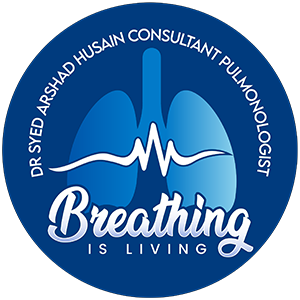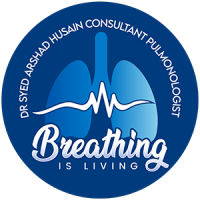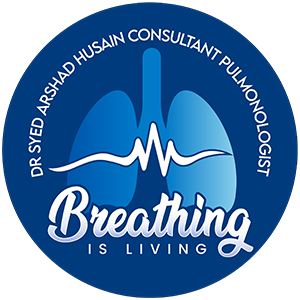Dr. Syed Arshad Husain Explains the Main Causes Breathing Difficulties

Strong 8k brings an ultra-HD IPTV experience to your living room and your pocket.
Breathing, an essential life process, is often taken for granted until a problem arises. Breathing difficulties, also known as dyspnea, can be a frightening experience and a sign of an underlying medical condition. Dr. Syed Arshad Husain, a leading pulmonologist in Dubai, sheds light on the various causes of breathing problems, emphasizing the importance of seeking professional medical evaluation for accurate diagnosis and appropriate management.
A Spectrum of Causes: From Simple to Serious
Breathing problems can stem from a variety of factors, ranging from temporary and easily treatable conditions to chronic and potentially life-threatening illnesses. Dr. Husain categorizes the main causes as follows:
1. Respiratory Conditions:
Asthma: This chronic inflammatory condition causes the airways to narrow and produce excess mucus, leading to wheezing, shortness of breath, chest tightness, and coughing. Triggers can include allergens, exercise, and respiratory infections.
Chronic Obstructive Pulmonary Disease (COPD): A progressive lung disease that encompasses conditions like emphysema and chronic bronchitis. Smoking is the primary risk factor. COPD damages the airways and air sacs in the lungs, making it difficult to breathe.
Respiratory Infections: Infections like pneumonia, bronchitis, and the common cold can inflame the airways and lungs, causing breathing difficulties. These infections can be caused by viruses, bacteria, or fungi.
Lung Cancer: Tumors in the lungs can obstruct airways, leading to shortness of breath, coughing, and chest pain. Early detection is crucial for successful treatment.
Pulmonary Embolism (PE): A blood clot in the lungs can cause sudden shortness of breath, chest pain, and coughing up blood. This is a medical emergency requiring immediate attention.
Pulmonary Fibrosis: A chronic condition characterized by scarring of lung tissue, making the lungs stiff and less elastic. This leads to progressive shortness of breath.
Pneumothorax (Collapsed Lung): Occurs when air leaks into the space between the lung and chest wall, causing the lung to collapse. This can be caused by injury or underlying lung disease.
2. Cardiac Conditions:
Heart Failure: The heart's inability to pump blood efficiently can lead to fluid buildup in the lungs, causing shortness of breath, especially with exertion or when lying down.
Heart Arrhythmias: Irregular heart rhythms can sometimes cause shortness of breath, chest pain, and dizziness.
3. Other Medical Conditions:
Anemia: A deficiency in red blood cells, which carry oxygen throughout the body, can lead to fatigue and shortness of breath.
Anxiety and Panic Attacks: These psychological conditions can trigger rapid breathing (hyperventilation), leading to shortness of breath, chest tightness, and dizziness.
Obesity: Excess weight can put pressure on the lungs and diaphragm, making breathing more difficult, especially during exertion.
Allergic Reactions: Severe allergic reactions (anaphylaxis) can cause swelling of the airways, leading to breathing difficulties. This is a medical emergency.
Neuromuscular Disorders: Conditions affecting the nerves and muscles involved in breathing, such as muscular dystrophy or myasthenia gravis, can cause respiratory weakness and shortness of breath.
4. Environmental Factors:
Air Pollution: Exposure to pollutants like smog, dust, and pollen can irritate the airways and trigger breathing problems, especially in individuals with pre-existing respiratory conditions.
High Altitude: The lower oxygen levels at high altitudes can cause shortness of breath, especially in individuals not acclimated to the altitude.
Dr. Husain's Expertise and Emphasis on Accurate Diagnosis:
Dr. Syed Arshad Husain is a highly skilled pulmonologist with extensive experience in diagnosing and treating a wide range of respiratory conditions. He emphasizes the importance of a thorough medical evaluation to determine the underlying cause of breathing problems. He utilizes advanced diagnostic tools and techniques to accurately assess lung function and identify any abnormalities.
When to Seek Medical Attention:
It is crucial to consult a doctor if you experience any of the following:
Sudden and severe shortness of breath
Chest pain accompanied by breathing difficulties
Coughing up blood
Wheezing or stridor (a high-pitched whistling sound)
Difficulty breathing that interferes with daily activities
Bluish discoloration of the skin or lips (cyanosis)
Remember: This information is for general knowledge and informational purposes only, and does not constitute medical advice. It is essential to consult with a qualified healthcare professional for any health concerns or before making any decisions related to your health or treatment. Do not delay seeking medical advice based on information provided here.
Note: IndiBlogHub features both user-submitted and editorial content. We do not verify third-party contributions. Read our Disclaimer and Privacy Policyfor details.



